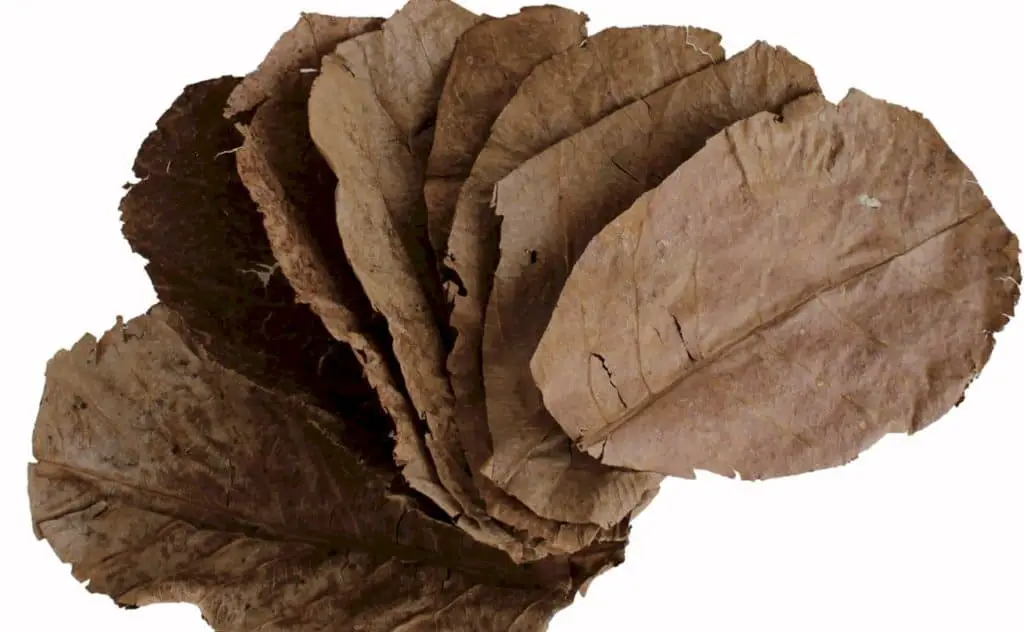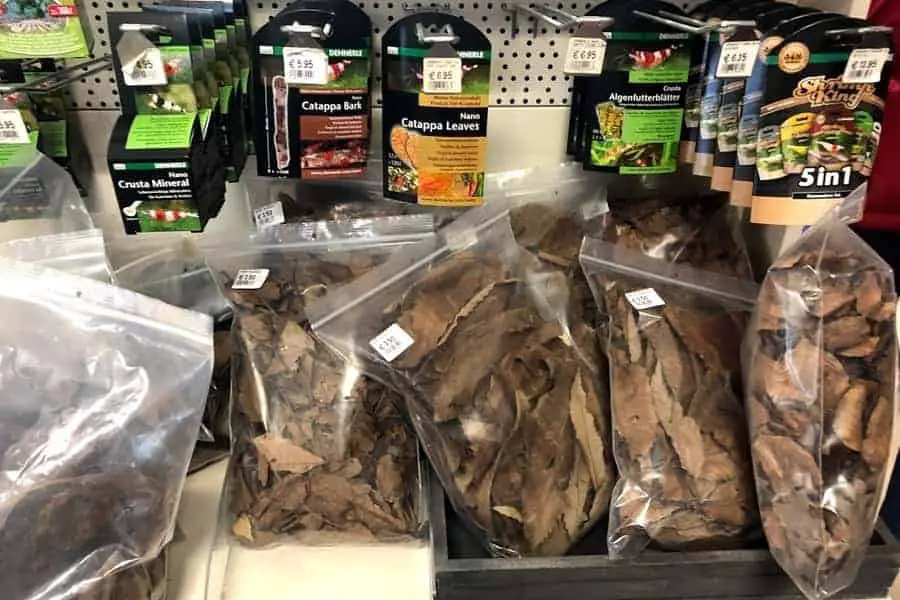Aquarium professionals and hobbyists have long utilized Catappa, or Indian Almond leaves, for various aquatic creatures. These leaves offer numerous benefits for shrimp aquariums, such as releasing antifungal and antibacterial tannins that help prevent illness and providing a surface for biofilm growth, which serves as a food source for shrimplets.
Indian Almond leaves benefit your shrimp by releasing antifungal and antibacterial tannins that can prevent your shrimp (and fish) from illness. They also have a surface where biofilm can thrive, providing a healthy food source for shrimplets.
Discover the benefits of Indian Almond leaves and how to use them effectively in your shrimp aquarium.
Benefits of the Catappa Leaves
Antifungal and Antibacterial Tannins
In nature, trees produce antibacterial and antifungal properties in their leaves to ensure healthy growth. These same properties are released when the leaves are submerged in water, providing a healthy environment for shrimp and fish.
Extra Biofilm Surface
Biofilm consists of bacteria, algae, fungi, and other multi-cellular organisms that form a layer on surfaces in your aquarium. Indian Almond leaves provide additional surfaces for biofilm growth, creating a rich food source for shrimp, particularly for shrimplets that struggle with larger food particles.
The biofilm on these leaves combined with the particles of the leave themselves breaking down will have all the proper nutrients of the biofilm and the leave combined. This biofilm surface is, therefore, an excellent food source for your shrimp and shrimplets. Especially for the little shrimplets that still have a problem with the larger food particles you feed your adult shrimp.
In general, shrimp love to eat biofilm

Trace Elements
As leaves break down in your aquarium, they release trace elements that benefit fish and shrimp, even if they don’t consume the biofilm or decaying leaves.
Hiding Spot for Shrimplets
Shrimp, shrimplets, and fish fry often seek shelter, especially after molting when they are vulnerable. Indian Almond leaves offer an excellent hiding place
Catappa Leaves Lower pH
The breakdown of organic material in your aquarium can cause a slight decrease in pH. Using Catappa leaves in small quantities can help maintain desired acidity levels.
A buffering substrate can compensate for the gradual drop in pH in the tank or by adding a bit of crushed corral if you want to maintain a certain level of acidity.
Using the Catappa leaves in small numbers, one or two at a time in a 10-gallon aquarium or larger, won’t make much of a difference. In larger quantities, they can lower the pH when desired, but a little peat moss in a bag in your tank or filter will be more effective.
Caridina shrimp generally like a slightly lower pH (depending on where they are from, 5.8 to 6.9) than Neocaridina (6.5 to 8), but they both will not show any adverse effect when you are not using their hands full at a time.
Usually, the shrimp won’t mind these little gradual changes, and the benefits outweigh this side effect by far, in my opinion.
It will take about two weeks for the leave to start breaking down. Depending on how many shrimp and snails are, it can take about two months until there is nothing but the skeleton (leave vanes) of the leave remaining.
How Many Indian Almond Leaves per Gallon?
Use one leaf per month for every 20 gallons. For example, use half a leaf for a 10-gallon tank or two leaves for a 40-gallon tank. Add leaves staggered throughout the month to avoid nitrate spikes.
In this case, I would advise putting in one every two weeks and not two at the same time, once a month, or you will have a chance to spike the nitrates, which your shrimp won’t like. You can vary this a bit, and if they don’t break down at this time, you can wait a little longer before you put the next Catappa in.
You can give them a bit more if you have a lot of shrimp and fish. You will develop a feeling for this soon.
If you don’t like seeing the big leaves in your tank, you can break them into smaller pieces and scatter them behind some plants or rocks.

Preparing Almond Leaves for Your Shrimp Tank
Rinse leaves under tap water to remove dust and loose particles. The leaves will release tannins and coloration into the water, which are beneficial for shrimp and fish. If you prefer to reduce the coloration, pre-soak or boil the leaves before use
The advantage of pre-soaking, or boiling, is that the leaves will sink to the bottom immediately when used in your aquarium. If you want to eliminate almost all the tannins (and most beneficial properties), boil the leaves before use. This way, like tea, you can cook all the coloration out of the leaves.
Keeping Catappa Leaves Submerged
Since Indian Almond leaves are usually dried, they may not sink immediately. To keep them submerged, you can:
Boil Them (which Also Releases Tannins)
Boiling the Almond leaves will get them waterlogged fast. It will also make them release most of the tannins. This is your best option if you place a high value on a crystal-clear water tank. This way, your shrimp can still benefit from the biofilm and the trace elements in the leaves, and you won’t get a slight tint in your water. The downside is that you will boil out most of your leaves’ Antifungal and Antibacterial properties.
Weigh Them Down with A Heavy Object
Weighing them down with a heavy object will submerge them until they are waterlogged enough to stay down by themselves. Eventually, the leaves will remain down, but if you don’t want to wait for this, or you don’t want a random chance to determine where your leave will end up, this can be a great option.
Stick Them in The Substrate or Hardscape
Usually, the leaves will still have a little stem where they were attached to the branch they grew on. You can use this small piece to stick the leave in the substrate or wedge it between a bit of hardscape.
Wait for Them to Sink Naturally
By far, the easiest thing to do is just put it in the tank and wait until it sinks. In the aquarium, the leave will, and when it is waterlogged, it will fall to the bottom. It will usually take a couple of days for the leaves to sink.
Are Indian Almond Leaves Necessary?
While not essential, Indian Almond leaves provide numerous benefits for shrimp, helping them thrive rather than survive.




